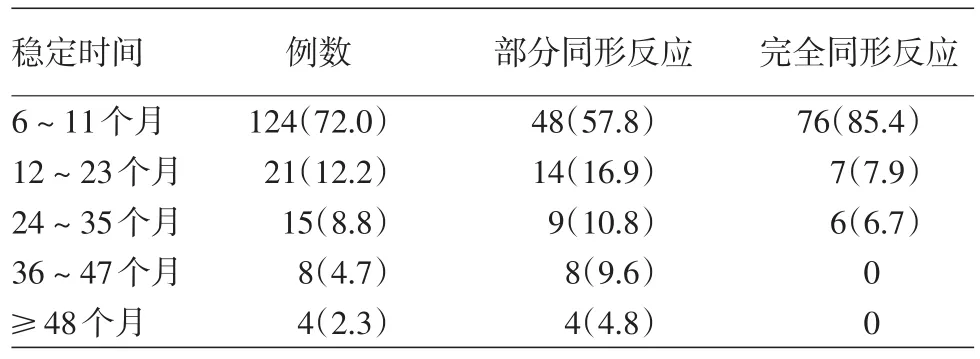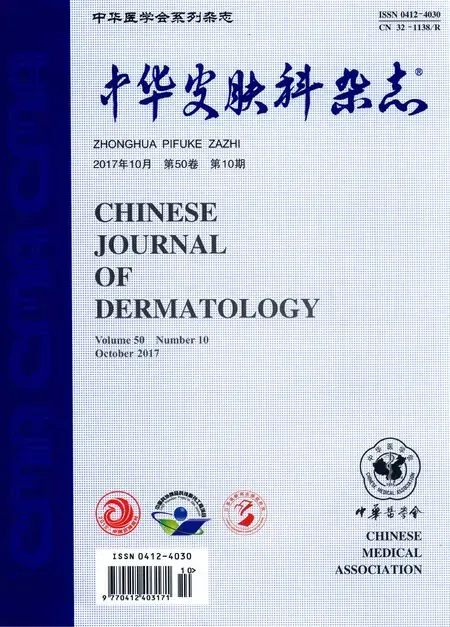白癜风黑素细胞移植供皮区同形反应严重程度与疗效的关系
黄骏 林福全 洪为松 傅丽芳 尉晓冬 许爱娥
310009杭州,浙江中医药大学附属杭州第三医院皮肤科
白癜风黑素细胞移植供皮区同形反应严重程度与疗效的关系
黄骏 林福全 洪为松 傅丽芳 尉晓冬 许爱娥
310009杭州,浙江中医药大学附属杭州第三医院皮肤科
目的 探讨白癜风黑素细胞移植供皮区同形反应严重程度在评估移植疗效中的作用。方法 2008年5月至2016年8月,在杭州市第三人民医院皮肤科接受黑素细胞(培养或混悬)移植治疗、供皮区出现同形反应的172例白癜风患者,依据供皮区同形反应面积分为两组:部分同形反应组(同形反应面积小于吸疱面积)和完全同形反应组(同形反应面积等于吸疱面积),分析两组的移植疗效及与同形反应相关性。结果 172例供皮区出现同形反应中,部分同形反应83例,完全同形反应89例。部分同形反应组痊愈21例(25.3%),显效17例(20.5%),有效率45.8%,有效率高于完全同形反应组[痊愈4例(4.5%),有效11例(12.4%),有效率16.9%,χ2=31.581,P <0.001]。部分同形反应组白癜风稳定时间(18.5±15.3)个月,高于完全同形反应组[(10.2±7.3)个月],t=4.581,P <0.001。相关分析显示,白癜风稳定时间(6~11个月、12~23个月、24~35个月、36~47个月、≥48个月)与同形反应严重程度(部分或完全)呈负相关(rs=-0.322,P<0.001),与复色率呈正相关(r=0.675,P<0.001)。结论 白癜风稳定时间是影响供皮区有同形反应患者黑素细胞移植疗效的重要因素,同形反应严重程度提示稳定时间长短,可预测移植疗效。
白癜风;黑素细胞;细胞移植;治疗结果;同形反应
目前治疗白癜风的方法较多,但治愈率较低[1-2]。对于稳定期白癜风患者,黑素细胞移植是一种较好的治疗方法。我们观察黑素细胞移植治疗的白癜风患者3 373例,发现172例患者供皮区发生不同程度同形反应,现分析移植疗效与同形反应严重程度的关系。
一、对象与方法
1.对象:收集2008年5月至2016年8月在杭州市第三人民医院皮肤科进行黑素细胞(培养或混悬)移植的白癜风患者3 373例,均为稳定期白癜风,稳定时间均>6个月。病期评估:2009年之前的患者参照白癜风疾病活动度评分(VIDA评分)[3],2009年至2014年1月之间参照白癜风治疗共识(2009版)[4],2014年1月之后参照白癜风诊疗共识(2014版)[5]。
2.观察及治疗方法:登记患者性别、年龄、病程、移植前糖皮质激素使用史或光疗史、稳定时间、同形反应情况和复色率。均用黑素细胞移植(培养或混悬)治疗,方法见文献[6],术后6个月复查。
3.供皮区同形反应分组:根据文献[7]将172例发生同形反应的白癜风患者分为部分同形反应(同形反应白斑面积<吸疱面积)组和完全同形反应(同形反应白斑面积等于吸疱面积)组。
4.疗效评价[8]:治疗前后拍照记录皮损,采用Adobe Photoshop7.0图像软件系统测复色面积。疗效标准:复色率≥90%为痊愈,50%~89%为显效,20%~49%为好转,<20%为无效。有效率=(痊愈+显效)例数/总例数×100%。
5.统计学处理:采用SPSS19.0统计学软件。两组间均值比较采用t检验,两组间率比较采用χ2检验,两因素间直线相关性检验采用Pearson或Spearman相关性检验。P<0.05为差异有统计学意义。
二、结果
1.一般情况:3 373例白癜风患者中,172例发生同形反应,其中部分同形反应83例,完全同形反应89例。两组间性别、年龄和病程比较,差异无统计学意义(均P>0.05),见表1。

表1 172例供皮区出现同形反应的白癜风患者临床资料
2.同形反应严重程度与稳定时间的关系:部分同形反应组白癜风稳定时间(18.5±15.3)个月,明显高于完全同形反应组[(10.2±7.3)个月],t=4.581,P <0.001,见表1。同形反应患者比例随着稳定时间的延长而降低,见表2。Spearman相关性检验表明,稳定时间(6~11个月、12~23个月、24~35个月、36~47个月、≥48个月)与同形反应严重程度(部分或完全)呈负相关(rs=-0.322,P<0.001)。
3.同形反应严重程度与疗效的关系:172例患者痊愈率14.5%,有效率30.8%。χ2检验显示,部分同形反应组疗效高于完全同形反应组,χ2=31.581,P<0.001。见表3。
4.同形反应严重程度和稳定时间与复色率的关系:部分同形反应组平均复色率(44.3±39.6)%,完全同形反应组为(16.7±28.0)%,两组间复色率差异有统计学意义(t=5.305,P < 0.001)。
稳定时间6~11个月、12~23个月、24~35个月、36~47个月、≥48个月组的复色率分别为(13.2±23.8)%、(61.5 ± 33.1)%、(87.7 ± 11.7)%、(85.0 ± 13.1)%、(57.0 ±28.9)%,稳定时间6~12个月组(124例)平均复色率明显低于>12个月组(48例)[(73.6±3.0)%,t=14.16,P<0.001]。Pearson直线相关性检验显示,稳定时间与复色率呈正相关(r=0.675,P < 0.001)。
三、讨论
同形反应发生的确切机制尚不明确,通常认为是白癜风进展的标志[9-11]。我们的结果显示,部分同形反应组白癜风稳定时间明显长于完全同形反应组。172例发生同形反应的患者中,稳定时间6~12个月者占72%,>48个月者仅占2.3%;而完全同形反应组6~12个月者占85.4%,无患者>48个月。相关分析显示,稳定时间与同形反应程度呈负相关,稳定时间短,易发生严重的同形反应。
稳定时间是影响疗效的重要因素,172例同形反应患者,稳定时间6~12个月组复色率明显低于>12个月组。相关分析表明,稳定时间与疗效呈正相关,提示白斑稳定时间越长疗效越好。洪为松等[12]的研究结果显示,稳定时间<1年的白癜风患者移植疗效差于稳定时间1~≥5年的患者,认为稳定时间是影响疗效的重要因素。我们的结果与洪为松等[12]的研究结果相符。
我们建议,待移植白斑在黑素细胞移植前予糖皮质激素或光疗治疗一段时间,再在2处正常皮肤吸疱(面积1 cm×1 cm)为窗口实验,1个月后若吸疱处无同形反应,表明病情稳定,可进行黑素细胞移植治疗,若出现同形反应,表明病情不稳定,此时不宜进行移植治疗。另外,Njoo等[3]认为,节段型白癜风不会发生同形反应。而van Geel等[13]却报道节段型白癜风可发生同形反应。本研究发现,172例同形反应患者中有22例节段型白癜风,表明节段型白癜风也可发生同形反应,至于同形反应为何较少见于节段型白癜风,可能与节段型与非节段型白癜风发生机制不同有关。本文结果显示,黑素细胞移植供皮区同形反应的轻重与疗效密切相关。应在稳定时间>1年后再进行移植治疗。

表2 172例白癜风患者稳定时间与供皮区同形反应严重程度的关系[例(%)]

表3 172例供皮区发生同形反应者移植疗效比较[例(%)]
[1]Grimes PE.New insights and new therapies in vitiligo[J].JAMA,2005,293(6):730-735.DOI:10.1001/jama.293.6.730.
[2]Gawkrodger DJ,Ormerod AD,Shaw L,et al.Guideline for the diagnosis and management of vitiligo[J].Br J Dermatol,2008,159(5):1051-1076.DOI:10.1111/j.1365-2133.2008.08881.x.
[3]Njoo MD,Das PK,Bos JD,et al.Association of the Köbner phenomenon with disease activity and therapeutic responsiveness in vitiligo vulgaris[J].Arch Dermatol,1999,135(4):407-413.
[4]中国中西医结合学会皮肤性病专业委员会色素病学组.白癜风治疗共识(2009版)[J].中华皮肤科杂志,2009,42(9):591-592.DOI:10.3760/cma.j.issn.0412-4030.2009.09.001.
[5]中国中西医结合学会皮肤性病专业委员会色素病学组.白癜风诊疗共识(2014版)[J].中华皮肤科杂志,2014,47(1):69-71.DOI:10.3760/cma.j.issn.0412-4030.2014.01.024.
[6]张迪敏,洪为松,傅丽芳,等.个体化培养自体黑素细胞移植治疗白癜风[J].中华皮肤科杂志,2010,43(10):721-725.DOI:10.3760/cma.j.issn.0412-4030.2010.10.015.
[7]黄骏,章玲玲,洪为松,等.自体培养黑素细胞移植治疗白癜风供皮区出现同形反应者的疗效及相关因素分析[J].中华皮肤科杂志,2017,50(3):186-189.DOI:10.3760/cma.j.issn.0412-4030.2017.03.008.
[8]中国中西医结合学会皮肤性病专业委员会色素病学组.白癜风临床分型及疗效标准(2003年修订稿)[J].中华皮肤科杂志,2004,37(7):440.DOI:10.3760/j.issn:0412-4030.2004.07.028.
[9]Hatchome N,Kato T,Tagami H.Therapeutic success of epidermal grafting in generalized vitiligo is limited by the Köebner phenomenon[J].J Am Acad Dermatol,1990,22(1):87-91.
[10]van Geel N,Speeckaert R,De Wolf J,et al.Clinical significance of Koebner phenomenon in vitiligo[J].Br J Dermatol,2012,167(5):1017-1024.DOI:10.1111/j.1365-2133.2012.11158.x.
[11]Hann SK,Chun WH,Park YK.Clinical characteristics of progressive vitiligo[J].Int J Dermatol,1997,36(5):353-355.
[12]洪为松,傅丽芳,尉晓冬,等.自体黑素细胞移植治疗243例面颈部白癜风疗效及相关因素分析[J/CD].中华移植杂志(电子版),2011,5(4):9-13.DOI:10.3877/cma.j.issn.1647-3903.2011.04.004.
[13]van Geel N,De Lille S,Vandenhaute S,et al.Different phenotypes of segmental vitiligo based on a clinical observational study[J].J Eur Acad Dermatol Venereol,2011,25(6):673-678.DOI:10.1111/j.1468-3083.2010.03847.x.
Relationship between the severity of isomorphic response at the donor site and the therapeutic effect of cultured melanocyte transplantation in patients with vitiligo
Huang Jun,Lin Fuquan,Hong Weisong,Fu Lifang,Wei Xiaodong,Xu Ai′e
Department of Dermatology,Hangzhou Third Hospital Affiliated to Zhejiang Chinese Medicine University,Hangzhou 310009,China
Xu Ai′e,Email:xuaiehz@msn.com
Objective To investigate the value of the severity of isomorphic response at the donor site in evaluation of the therapeutic effect of cultured melanocyte transplantation.Methods A total of 172 vitiligo patients,who
cultured melanocyte transplantation or non-cultured epidermal suspension transplantation at the Department of Dermatology of Hangzhou Third Hospital from May 2008 to August 2016 and developed isomorphic response at the donor site,were enrolled into this study.According to the area of isomorphic response,these patients were divided into 2 groups:incomplete isomorphic response group whose area of isomorphic response was less than the suction area,and complete isomorphic response group whose area of isomorphic response was equal to the suction area.The correlation between therapeutic effects of melanocyte transplantation and isomorphic response was analyzed.Results Of the 172 patients,83 had incomplete isomorphic response,and 89 had complete isomorphic response at the donor site.In the incomplete isomorphic response group,21(25.3%)patients were cured,and 17(20.5%)were markedly improved,while 4(4.5%)patients were cured,and 11(12.4%)were improved in the complete isomorphic response group.Additionally,the response rate was significantly higher in the incomplete isomorphic response group than in the complete isomorphic response group(45.8%vs.16.9%,χ2=31.581,P < 0.001).Furthermore,the duration of stable phase was also significantly longer in the incomplete isomorphic response group than in the complete isomorphic response group(18.5±15.3 months vs.10.2±7.3 months,t=4.581,P < 0.001).Correlation analysis showed that the duration of stable phase,which was classified into 5 grades including 6-11 months,12-23 months,24-35 months,36-47 months and≥48 months,was negatively correlated with the severity(incomplete or complete)of isomorphic response(rs=-0.322,P < 0.001),but positively correlated with repigmentation rates of the skin lesions(rs=0.675,P < 0.001).Conclusion The length of duration of stable phase is an important factor affecting the therapeutic effect of melanocyte transplantation in vitiligo patients with isomorphic response at the donor site,and the severity of isomorphic response can indicate the length of duration of stable phase and predict the therapeutic effect of melanocyte transplantation.
Vitiligo;Melanocytes;Cell transplantation;Treatment outcome;Koebner phenomenon
许爱娥,Email:xuaiehz@msn.com
10.3760/cma.j.issn.0412-4030.2017.10.014
国家自然科学基金(81271758、81472887);卫生部科学研究基金——浙江省医药卫生重大科技计划(WKJ2012-2-036);杭州市重大科技创新项目(20122513A02)
Fund programs:National Natural Science Foundation of China(81271758,81472887);Scientific Research Fund of Ministry of Health--Major Science and Technology Project of Zhejiang Province(WKJ2012-2-036);the Major Science and Technology Innovation Projects of Hangzhou(20122513A02)
2016-10-21)
(本文编辑:吴晓初)

